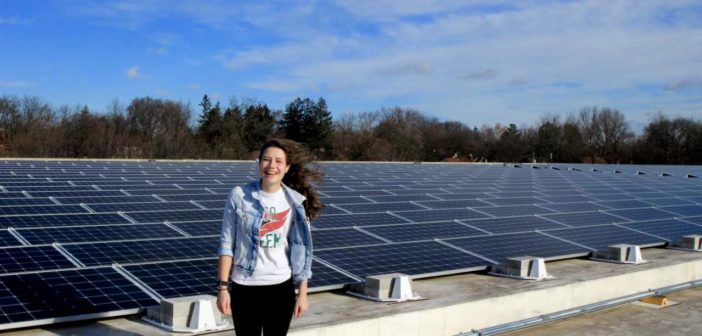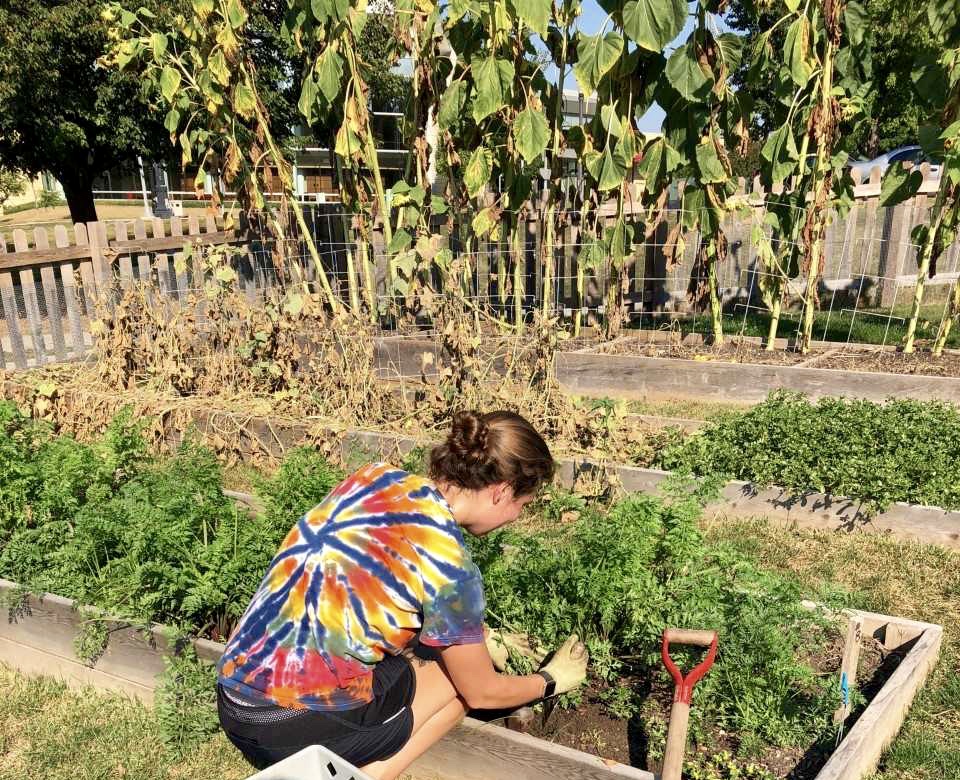What do you see as you look around NCC’s campus? Do you notice the old architecture, the heart of downtown Naperville around the corner, the point of the church looming over the skyline, or the next available parking spot?
At NCC there’s the more obvious features and the more subtle ones hiding under the surface.
For the environmentally aware members of campus, the efforts to be sustainable are at the top of their list.
From different kinds of solar panels on top of ResRec and New Hall to waste organization to permeable pavers to electric car stations to LEED-certified buildings to a community garden, there’s a lot to see.
According to Jeffrey Anstine, professor of management and coordinator of environmental studies, when he first got here five or six years ago there were few efforts on sustainability on campus. So, he and other professors led the way toward an environmental studies track and more sustainable efforts here at NCC.
“I think these efforts are spectacular,” Anstine said. “In the last few years we went from almost nothing to it being a huge part of the campus. Our new strategic plan is to continue to promote environmental initiatives across campus.”
With an effort to be green on the academic level, is the movement given enough of a green light on campus?
According to Martha Bohrer, an English professor and a coordinator of environmental studies, under President Troy Hammond, the campus is doing far more than other schools this size. This would include NCC’s largest solar array on top of ResRec than any private institution of higher education in Illinois.
“I give President (Troy) Hammond a lot of credit for putting real money behind our efforts and a real commitment to it. It’s a very serious and committed action on this campus to be a more sustainable institution,” Bohrer said.
According to Anna Halverson, president of Green Scene and a student worker at the Office of Sustainability, these efforts are spurred from the passion of students and administration. The Green Scene is a group dedicated to environmental initiatives throughout campus.
“These things aren’t cheap. They aren’t doing this because it’s fun. People don’t necessarily know about it which goes to show that it’s not for show,” Halverson said. “They do it because they care and really, because we can.”
Projects such as the pavers and the solar panels do a lot for the school’s image. But beyond image is an overall passion for leading and teaching a different kind of environmental education.
According to Anstine, the college’s expansion of its environmental education has led to more students enrolling at NCC for the sustainability business track or policy track.
“I like how we only have one environmental science professor and the rest are from different disciplines,” Halverson said. “I took environmental economics with an economics professor. You take environmental literature with an English professor. You really get more specific education from people in the field. I love how interdisciplinary it is, I’ve learned so much from different people.”
While a lot of the college’s sustainability efforts coming from the administration level, students have a voice and the tools for living a more green and minimalist lifestyle.
According to Halverson, students can have a lot of impact on the school’s sustainability. Two major things are reducing and recycling. Simple things like bringing your own water bottle and coffee mug.
“Recycling is so hard for some people,” Halverson said. “There’s a lack of education we aren’t taught at a young age or in school or anything. I’ve seen people get paralyzed at the Cage because there’s three bins. It’s just about learning to slow down for a second.”
From learning where to put your empty coffee cup to simply noticing the cans under your hand, Halverson says that one of Green Scene’s largest initiatives is just getting people to realize what is around them on campus.
“One thing we are working to improve right now is education. People just don’t know all the things we have on campus,” Halverson said. “We have rain gardens, we have permeable pavements, we have three types of renewable energy, we have the prairie point, we have an initiative to help the bees. This isn’t normal. This isn’t what most colleges are like.”
Part of the issue is learning how to bridge the gap between environmental knowledge and an actual commitment to make an environmental impact on the school and the overall surrounding community.
According to Bohrer, to bridge this gap there needs to be a change at the student and faculty level. From leading things like Meatless Mondays to reaching out to Naperville businesses urging them to be more green to making a commitment to stop selling plastic bottles on campus, being green is an individual effort.
“What I hope for more than anything is that you guys are the next generation, so if we taught you good recycling habits and eating habits, these are things that you’re going to take with you whatever places you go,” Bohrer said. “You can start saying to a business you work for things like ‘have we thought about alternative ways to heat our water’ and that’s really how any college has its influence in the world.”
With downtown Naperville a few feet away and the Naperville community in the backyard of NCC’s campus, it’s interesting to know if the urge to be green is spreading.
According to an article addressing college student’s energy consumption, a study examining 15 different colleges in the United States and Canada found that in one year a four-year college used 9,776.85 total kilowatt hours of consumption per student. This is far above the sample of 6,481.52 from the average person. What does this mean? Basically that students use about one-third more energy than the typical person.
So, the struggle for colleges to show students and faculty how they as a unit can make an impact on the school’s green level has become an important initiative.
“We have access to close to 3,000 people on this campus. If we can change 10 percent of people’s reduction habits for things like recycling,” Halverson said. “Those things won’t just stay on campus they’ll have those skills for life. If we can educate on campus we’re changing their lifestyle and their impact forever.”
Living in Naperville, a fairly affluent neighborhood, spreading a change in lifestyle is something that can make a change in sustainability efforts of people living in this area. Naperville already has a set of sustainability efforts.
“I wonder how many houses are looking down at the valley and the solar panels down at that part of campus. At least our efforts at reducing energy consumption are pretty visible,” Bohrer said.


